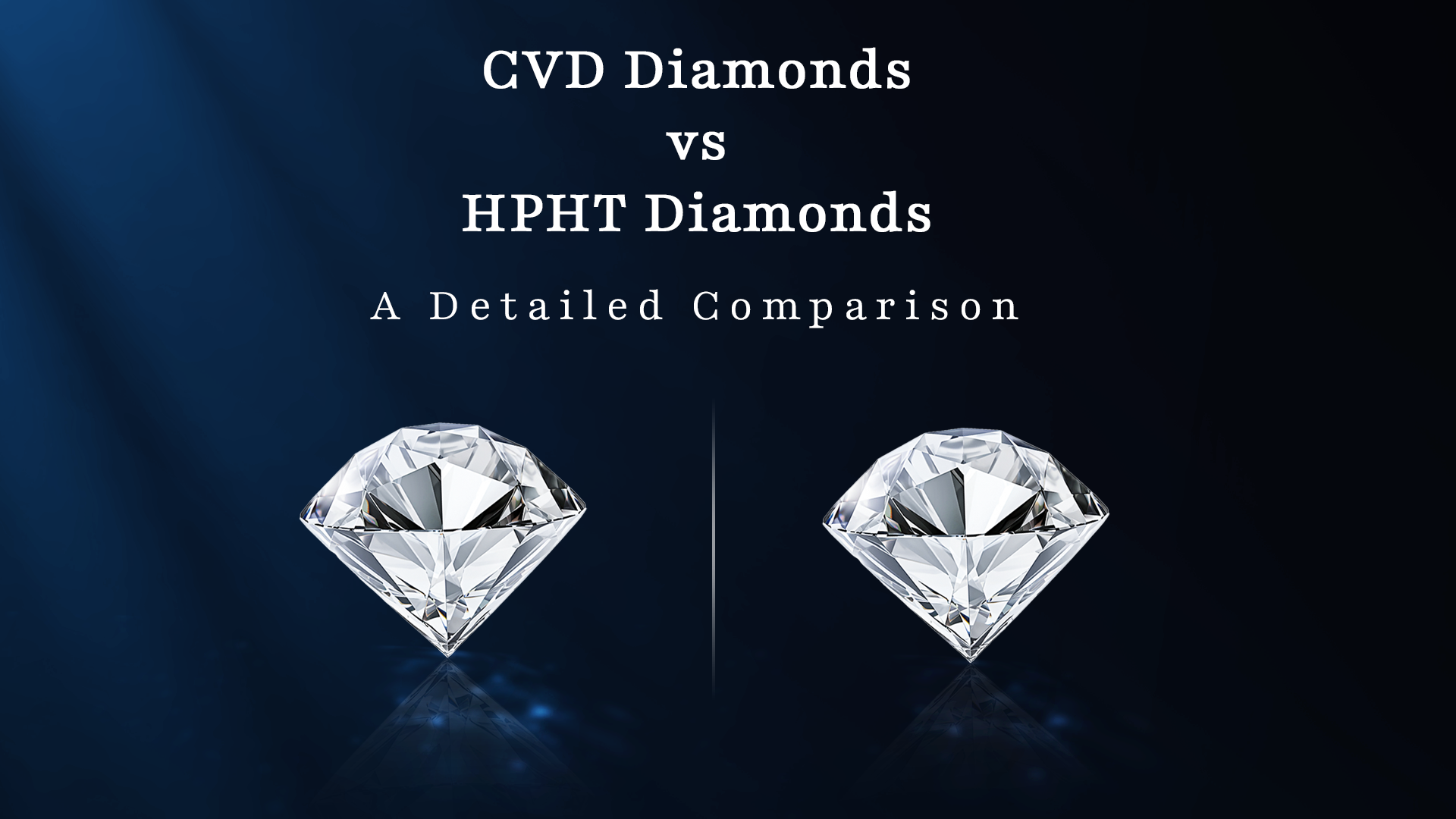There was a time when diamonds were all about that one kind—natural diamonds, formed over billions of years deep within the Earth’s crust. But times have changed, and so have your options. Today, consumers like you have a wealth of choices, thanks to advancements in technology. Among these choices, lab-grown diamonds have emerged as a popular and ethical alternative to natural diamonds.
But did you know that within the world of lab-grown diamonds, there are two main types? Let’s explore the fascinating comparison between CVD diamonds and HPHT diamonds in this blog. Both produce beautiful, genuine diamonds, but they’re made in different ways and have distinct characteristics.
If you’re in the market to buy a diamond, understanding the differences between CVD diamonds and HPHT diamonds can help you make the best choice for your needs.
The Basics: How Are They Made?
CVD Diamonds
CVD diamonds are created through a process called Chemical Vapour Deposition. In this method, a diamond seed (a small piece of a diamond) is placed inside a chamber filled with carbon-rich gases, like methane. The gases are then heated to the point where the carbon atoms break apart and begin to bond with the seed, layer by layer, gradually forming a diamond. This process mimics the natural formation of diamonds but happens much faster—think weeks instead of billions of years!
HPHT Diamonds
HPHT diamonds, on the other hand, are made using the High Pressure High Temperature method. This process also starts with a diamond seed but involves recreating the extreme heat and pressure conditions found deep within the Earth. The seed is placed in a press and subjected to high pressure and temperatures of around 1,500°C. This causes carbon to melt and bond with the seed, forming a diamond.
Let’s talk about Appearance and Quality
At first glance, both CVD and HPHT diamonds look identical to natural diamonds. They’re graded on the same 4Cs—cut, color, clarity, and carat—so you can expect the same brilliance and fire. However, there are some subtle differences you might want to consider like:
Cut
CVD diamonds grow in layers, which can sometimes create unique internal structures that require careful consideration during cutting. On the other hand, HPHT diamonds grow in a more crystal-like structure, similar to natural diamonds, making the cutting process more straightforward. Regardless, skilled gem cutters can achieve excellent results with both types, ensuring that your diamond has that stunning sparkle.
Color
CVD diamonds tend to have a brownish or greyish tint when they’re first created, but this can be corrected with post-growth treatments. HPHT diamonds often come out with a yellowish tint due to the nitrogen present during the growth process, but they can also be treated to enhance their color.
Clarity
CVD diamonds generally have fewer inclusions compared to HPHT diamonds. This is because the growth process is more controlled, leading to a purer diamond.
HPHT diamonds, however, can sometimes show metallic inclusions due to the metal catalyst used in the process.
Carat
CVD diamonds can be grown in controlled layers, allowing for more consistent and potentially larger diamonds. This makes them a good option if you’re looking for a larger stone without breaking the bank.
HPHT diamonds can also be grown to substantial sizes, but the process can sometimes be more challenging due to the intense conditions required. However, many HPHT diamonds still achieve significant carat weights, offering a good range of sizes for various budgets.
Cost Considerations
When it comes to cost, both CVD and HPHT diamonds are typically 70%-80% less expensive than natural diamonds. This is one of the biggest advantages of choosing a lab-grown diamond. However, between the two, CVD diamonds can be slightly more expensive than HPHT diamonds because the process allows for greater control over the quality and size of the diamond.
Which Should You Choose?
Choosing between a CVD and an HPHT diamond ultimately comes down to your personal preferences and priorities.
If you’re looking for a diamond with fewer inclusions and don’t mind spending a bit more, a CVD diamond might be the way to go. On the other hand, if you’re looking for a more budget-friendly option and don’t mind a diamond with a few more inclusions, an HPHT diamond could be the perfect fit.
You can find a variety of beautiful bracelets, earrings, rings, necklaces, mangalsutras and more, crafted from CVD diamonds along with authenticity certificates from SGL and IGI at Jewelbox.
FAQs
Which type of diamond is more environmentally friendly?
Both CVD diamonds and HPHT diamonds are considered more environmentally friendly and ethical compared to mined diamonds. They do not involve the environmental damage or ethical concerns associated with diamond mining. Both methods use less energy and do not contribute to conflict or unethical labour practices.
How do CVD diamonds and HPHT diamonds affect the resale value?
CVD diamonds might have a slightly higher resale value due to their more controlled production process, which often results in fewer inclusions and more colour options. However, the resale market for lab-grown diamonds is still developing, so values can fluctuate based on demand and market trends.
How does the choice between CVD and HPHT diamonds impact the diamond’s durability?
Both CVD diamonds and HPHT diamonds are equally durable and hard. They score a 10 on the Mohs scale of hardness, just like natural diamonds. The differences between CVD and HPHT diamonds do not affect their durability or overall strength. Whether you choose CVD or HPHT, you’ll get a diamond that is resistant to scratching and everyday wear, ensuring that it remains beautiful and enduring over time.




